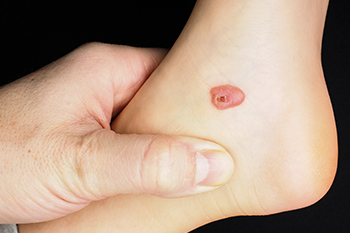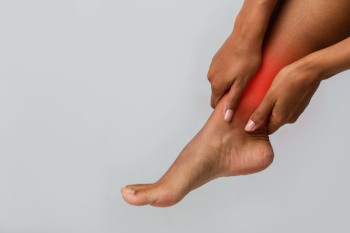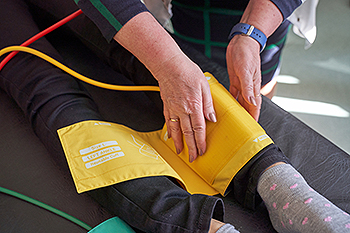Items filtered by date: February 2024
Dealing With Blood Blisters on the Feet

Blood blisters on the feet and toes can result from various factors, including sustained pressure or friction on the skin without breaking the skin’s surface. This is common in activities like running, dancing, or wearing ill-fitting shoes. Blood blisters look like friction blisters, but are filled with blood instead of clear fluid. They may appear red, purple, or black. While blood blisters may look scary, they are generally common and not usually a cause for alarm. Treatment typically involves allowing the blister to heal naturally over one to two weeks, with the formation of new skin beneath the blister. It's essential to protect the blister during this time, possibly by applying a bandage or similar protective covering. Prevention strategies to avoid developing blood blisters on the feet or toes include well-fitting footwear, protective gear during activities, and moisture-wicking socks to reduce sweat and friction. If the blood blister becomes painful or shows signs of infection, it is suggested that you make an immediate appointment with a podiatrist.
Blisters are prone to making everyday activities extremely uncomfortable. If your feet are hurting, contact Jack A. Sasiene, DPM of Texas. Our doctor can provide the care you need to keep you pain-free and on your feet.
Foot Blisters
Foot blisters develop as a result of constantly wearing tight or ill-fitting footwear. This happens due to the constant rubbing from the shoe, which can often lead to pain.
What Are Foot Blisters?
A foot blister is a small fluid-filled pocket that forms on the upper-most layer of the skin. Blisters are filled with clear fluid and can lead to blood drainage or pus if the area becomes infected.
How Do Blisters Form?
Blisters on the feet are often the result of constant friction of skin and material, usually by shoe rubbing. Walking in sandals, boots, or shoes that don’t fit properly for long periods of time can result in a blister. Having consistent foot moisture and humidity can easily lead to blister formation.
Prevention & Treatment
It is important to properly care for the affected area in order to prevent infection and ease the pain. Do not lance the blister and use a Band-Aid to provide pain relief. Also, be sure to keep your feet dry and wear proper fitting shoes. If you see blood or pus in a blister, seek assistance from a podiatrist.
If you have any questions, please feel free to contact our office located in Lake Jackson, TX . We offer the newest diagnostic and treatment technologies for all your foot care needs.
Understanding the Discomfort Behind Ankle Pain

Ankle pain can stem from various underlying factors, impacting mobility and daily activities. The ankle joint, comprising bones, ligaments, tendons, and muscles, facilitates essential movements like walking, running, and jumping. When this complex structure experiences stress, injury, or inflammation, it can result in discomfort and restricted movement. Common causes of ankle pain include sprains, caused by sudden twists or impacts that overstress the ligaments, and strains, which involve the stretching or tearing of muscles or tendons surrounding the ankle joint. Additionally, conditions such as arthritis, tendonitis, and fractures can contribute to persistent ankle pain, necessitating medical attention and intervention. Poor footwear choices, overuse during physical activities, and underlying health conditions can also make ankle discomfort worse. If you have ankle pain, it is suggested that you schedule an appointment with a podiatrist who can determine what the cause is and offer appropriate treatment methods.
Ankle pain can have many different causes and the pain may potentially be serious. If you have ankle pain, consult with Jack A. Sasiene, DPM from Texas. Our doctor will assess your condition and provide you with quality foot and ankle treatment.
Ankle pain is any condition that causes pain in the ankle. Due to the fact that the ankle consists of tendons, muscles, bones, and ligaments, ankle pain can come from a number of different conditions.
Causes
The most common causes of ankle pain include:
- Types of arthritis (rheumatoid, osteoarthritis, and gout)
- Ankle sprains
- Broken ankles
- Achilles tendinitis
- Achilles tendon rupture
- Stress fractures
- Tarsal tunnel syndrome
- Plantar fasciitis
Symptoms
Symptoms of ankle injury vary based upon the condition. Pain may include general pain and discomfort, swelling, aching, redness, bruising, burning or stabbing sensations, and/or loss of sensation.
Diagnosis
Due to the wide variety of potential causes of ankle pain, podiatrists will utilize a number of different methods to properly diagnose ankle pain. This can include asking for personal and family medical histories and of any recent injuries. Further diagnosis may include sensation tests, a physical examination, and potentially x-rays or other imaging tests.
Treatment
Just as the range of causes varies widely, so do treatments. Some more common treatments are rest, ice packs, keeping pressure off the foot, orthotics and braces, medication for inflammation and pain, and surgery.
If you have any questions please feel free to contact our office located in Lake Jackson, TX . We offer the newest diagnostic tools and technology to treat your foot and ankle needs.
Orthotics as a Solution for Children’s Foot Problems
 Orthotics, special inserts that are worn inside the shoe, can provide foot support, promote healthy foot development, and help alleviate foot-related pain for children. Children's feet are continually growing and developing, and certain conditions, such as flat feet or foot misalignments, may benefit from orthotic intervention. Orthotics designed for children can help correct gait abnormalities, improve foot alignment, and minimize pain associated with common problems like plantar fasciitis or shin splints. By providing additional support to growing feet, orthotics contribute to optimal biomechanics and can prevent the progression of certain foot conditions. If your child is experiencing foot-related pain or other foot issues, it is suggested you consult with a podiatrist who can discuss the possibility of orthotics tailored to your child’s growing feet or other treatment solutions.
Orthotics, special inserts that are worn inside the shoe, can provide foot support, promote healthy foot development, and help alleviate foot-related pain for children. Children's feet are continually growing and developing, and certain conditions, such as flat feet or foot misalignments, may benefit from orthotic intervention. Orthotics designed for children can help correct gait abnormalities, improve foot alignment, and minimize pain associated with common problems like plantar fasciitis or shin splints. By providing additional support to growing feet, orthotics contribute to optimal biomechanics and can prevent the progression of certain foot conditions. If your child is experiencing foot-related pain or other foot issues, it is suggested you consult with a podiatrist who can discuss the possibility of orthotics tailored to your child’s growing feet or other treatment solutions.
If you are having discomfort in your feet and would like to try orthotics, contact Jack A. Sasiene, DPM from Texas. Our doctor can provide the care you need to keep you pain-free and on your feet.
What Are Orthotics?
Orthotics are inserts you can place into your shoes to help with a variety of foot problems such as flat feet or foot pain. Orthotics provide relief and comfort for minor foot and heel pain but can’t correct serious biomechanical problems in your feet.
Over-the-Counter Inserts
Orthotics come in a wide variety of over-the-counter inserts that are used to treat foot pain, heel pain, and minor problems. For example, arch supports can be inserted into your shoes to help correct overarched or flat feet, while gel insoles are often used because they provide comfort and relief from foot and heel pain by alleviating pressure.
Prescription Orthotics
If over-the-counter inserts don’t work for you or if you have a more severe foot concern, it is possible to have your podiatrist prescribe custom orthotics. These high-quality inserts are designed to treat problems such as abnormal motion, plantar fasciitis, and severe forms of heel pain. They can even be used to help patients suffering from diabetes by treating foot ulcers and painful calluses and are usually molded to your feet individually, which allows them to provide full support and comfort.
If you are experiencing minor to severe foot or heel pain, it’s recommended to speak with your podiatrist about the possibilities of using orthotics. A podiatrist can determine which type of orthotic is right for you and allow you to take the first steps towards being pain-free.
If you have any questions, please feel free to contact our office located in Lake Jackson, TX . We offer the newest diagnostic and treatment technologies for all your foot care needs.
Symptoms and Risk Factors of Peripheral Artery Disease

Peripheral artery disease, or PAD, affects approximately 10 million adults in the U.S., with about five percent of those over 50. The condition is slightly more prevalent in men. Peripheral artery disease is caused by clogged arteries that block the flow of blood to the lower legs and feet. Risk factors include high cholesterol, smoking, diabetes, and hypertension. Others are family history, chronic renal failure, obesity, and physical inactivity. Common symptoms can include intermittent pain with exercise and severe pain in legs, especially at night. Additional signs of PAD are numbness, weakness, and muscle atrophy in legs, coldness and color changes in feet, and hair loss on the arms and legs. Thickening toenails and poor wound healing, which may lead to ulcers and gangrene, are also telltale signs of PAD. Prompt recognition of symptoms and risk factors is important to prevent complications that can include tissue damage. If you are experiencing symptoms of PAD in the lower leg and feet, it is suggested that you visit a podiatrist for a thorough exam.
Peripheral artery disease can pose a serious risk to your health. It can increase the risk of stroke and heart attack. If you have symptoms of peripheral artery disease, consult with Jack A. Sasiene, DPM from Texas. Our doctor will assess your condition and provide you with quality foot and ankle treatment.
Peripheral artery disease (PAD) is when arteries are constricted due to plaque (fatty deposits) build-up. This results in less blood flow to the legs and other extremities. The main cause of PAD is atherosclerosis, in which plaque builds up in the arteries.
Symptoms
Symptoms of PAD include:
- Claudication (leg pain from walking)
- Numbness in legs
- Decrease in growth of leg hair and toenails
- Paleness of the skin
- Erectile dysfunction
- Sores and wounds on legs and feet that won’t heal
- Coldness in one leg
It is important to note that a majority of individuals never show any symptoms of PAD.
Diagnosis
While PAD occurs in the legs and arteries, Podiatrists can diagnose PAD. Podiatrists utilize a test called an ankle-brachial index (ABI). An ABI test compares blood pressure in your arm to you ankle to see if any abnormality occurs. Ultrasound and imaging devices may also be used.
Treatment
Fortunately, lifestyle changes such as maintaining a healthy diet, exercising, managing cholesterol and blood sugar levels, and quitting smoking, can all treat PAD. Medications that prevent clots from occurring can be prescribed. Finally, in some cases, surgery may be recommended.
If you have any questions, please feel free to contact our office located in Lake Jackson, TX . We offer the newest diagnostic and treatment technologies for all your foot care needs.

